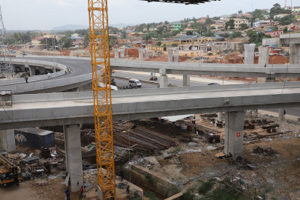Pointing overhead to the imposing structure of concrete pillars and tiered, swirling highways, 63-year-old Ayorkor Baka, like many others, welcomes the new interchange, saying it will cut pedestrian fatalities on the road linking Accra and Nsawam.
The bridge, the first of its kind in West Africa, is a crucial link between the capital and the middle belt via Ghana’s second-largest city of Kumasi. Overall, the interchange is 87% complete, according to the site engineers. They have announced plans to gradually open the facility in phases until its full completion in March 2021.
Four years ago, Baka lost her 11-year-old granddaughter on the same stretch of road. The girl died from injuries three days after she was hit by a vehicle while crossing the highway.
“The sight of this new bridge gives me mixed feelings – but what matters to me most is that it has come to save lives. It is a significant means to ending the carnage on the road,” Baka said. The new interchange is designed to separate high-speed traffic from pedestrian road users and has footbridges for safe crossings.
Official records show that at least 15 people were killed and several others were injured on the stretch of highway in the last four years. In one incident, two people died instantly when an articulated truck rammed into seven other cars, causing a pile-up.
The African Development Fund, the concessional arm of the African Development Bank Group provided a $83.9 million loan for the construction of the four-tier Pokuase Interchange and other upgrading work, which began in March 2018 and is expected to be completed by the end of the first quarter of 2021.

On 25 November 2020, President Nana Akufo Addo partially opened the bridge to ease traffic congestion.
The works form part of the Accra Urban Transport Project (AUTP) approved by the Bank in 2016 to promote efficient and safe movement of goods and people in and out of Ghana’s capital city, boost trade along the connecting routes and improve the people’s livelihoods.
The project’s beneficiaries are local factories and agro-industries, transporters and travelers on the Accra-Kumasi road corridor, which is the main transit route for food produced in Ghana’s middle belt breadbasket to Accra.
The project, which aligns to the Bank’s High-5 priorities on regional integration and improving the quality of life for the people of Africa, forms part of the wider Ghana-Burkina Faso road corridor.
In addition to the interchange, the AUTP entails the construction of 10 km of roads, 5 km of storm drains, the relocation of electricity, water and telephone utilities, and facilities to safeguard the environment. The project also provides ICT equipment and training for 14 schools in the area and supports two women’s groups in using ICT to improve their microbusiness.
Like granny Baka, trucker Foster Adadevoh says the bridge and associated works will greatly impact livelihoods, not only in the local communities but also to the benefit of commuters and traders, especially women carting perishable foodstuffs from the forest belt to the capital.
“Motorists like me can now heave a sigh of relief…it’s also a great relief to my customers. Sometimes, we spend more than an hour in this part of the traffic,” said Adadevoh, who hauls crates of tomatoes from northern Ghana to the capital.
Such projects form an essential part of improving the lives of Africans. According to the Bank’s 2020 Annual Development Effectiveness Review, quality of life has gradually improved on the continent, in part as a result of Bank-funded projects, in particular access to infrastructure.
The report highlights the role that roads have played in communities. Around the Awoshi-Pokuase road, for example, 103,000 people gained access to a clean water source and monthly household spending increased by 10%. The 14 km road financed by the Bank was completed in 2016. The report cautions, however, that not all improvements in living conditions are directly attributed to Bank investments.
“In 2018, when we broke the ground for this project, we were talking about a concept, but today we are talking about a reality that will greatly impact on livelihoods,” Resident Engineer Kwabena Bempong said.
The African Development Bank’s portfolio in Ghana is valued at around $800 million since 2013, with around 40.4% of its funding supporting the country’s transport sector. Notable among the projects is the Kotoka International Airport Terminal 3, which opened to travelers in September 2018. Other sectors it supports are agriculture, at 31.7%; multi-sector at 10.6%; as well as power, water and sanitation and finance










